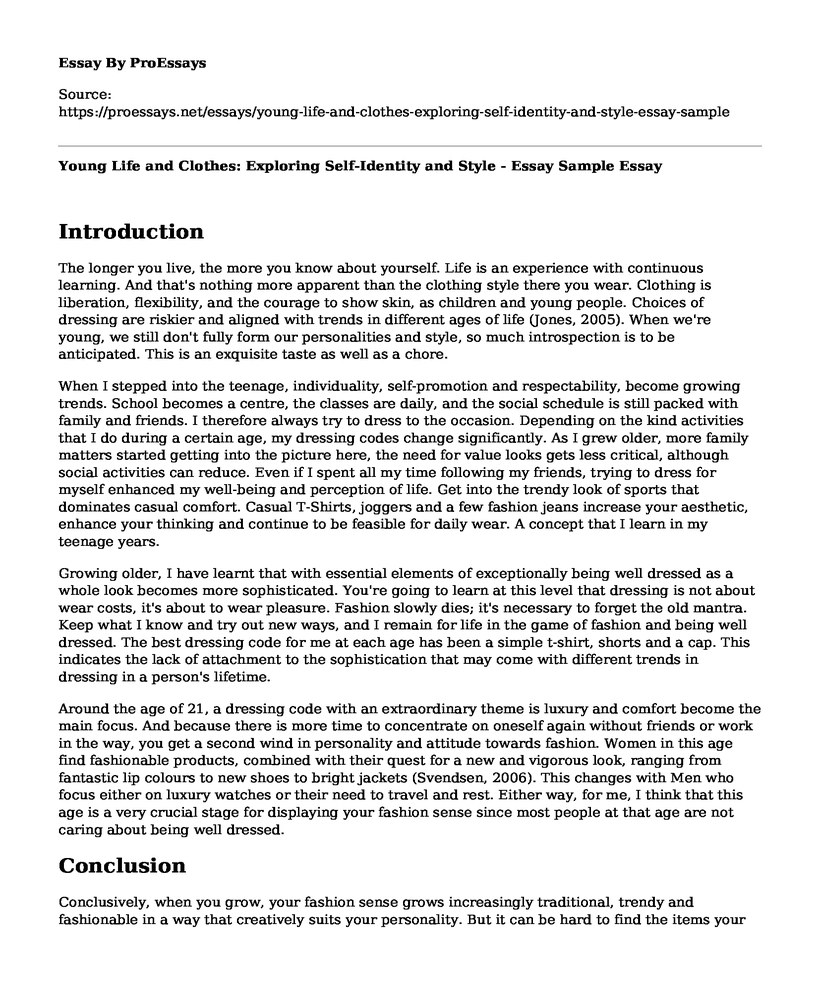Introduction
The longer you live, the more you know about yourself. Life is an experience with continuous learning. And that's nothing more apparent than the clothing style there you wear. Clothing is liberation, flexibility, and the courage to show skin, as children and young people. Choices of dressing are riskier and aligned with trends in different ages of life (Jones, 2005). When we're young, we still don't fully form our personalities and style, so much introspection is to be anticipated. This is an exquisite taste as well as a chore.
When I stepped into the teenage, individuality, self-promotion and respectability, become growing trends. School becomes a centre, the classes are daily, and the social schedule is still packed with family and friends. I therefore always try to dress to the occasion. Depending on the kind activities that I do during a certain age, my dressing codes change significantly. As I grew older, more family matters started getting into the picture here, the need for value looks gets less critical, although social activities can reduce. Even if I spent all my time following my friends, trying to dress for myself enhanced my well-being and perception of life. Get into the trendy look of sports that dominates casual comfort. Casual T-Shirts, joggers and a few fashion jeans increase your aesthetic, enhance your thinking and continue to be feasible for daily wear. A concept that I learn in my teenage years.
Growing older, I have learnt that with essential elements of exceptionally being well dressed as a whole look becomes more sophisticated. You're going to learn at this level that dressing is not about wear costs, it's about to wear pleasure. Fashion slowly dies; it's necessary to forget the old mantra. Keep what I know and try out new ways, and I remain for life in the game of fashion and being well dressed. The best dressing code for me at each age has been a simple t-shirt, shorts and a cap. This indicates the lack of attachment to the sophistication that may come with different trends in dressing in a person's lifetime.
Around the age of 21, a dressing code with an extraordinary theme is luxury and comfort become the main focus. And because there is more time to concentrate on oneself again without friends or work in the way, you get a second wind in personality and attitude towards fashion. Women in this age find fashionable products, combined with their quest for a new and vigorous look, ranging from fantastic lip colours to new shoes to bright jackets (Svendsen, 2006). This changes with Men who focus either on luxury watches or their need to travel and rest. Either way, for me, I think that this age is a very crucial stage for displaying your fashion sense since most people at that age are not caring about being well dressed.
Conclusion
Conclusively, when you grow, your fashion sense grows increasingly traditional, trendy and fashionable in a way that creatively suits your personality. But it can be hard to find the items your lifestyle needs when so many shops often sell clothes for a more youthful audience. To keep up with trends, switch the emphasis from fashionable to time-testing products. A must-have are classically white shirts, black pants and lock suit (Jones, 2005). This choice leads to a more sophisticated look which makes your style iconic regardless of the generation in which we are.
References
Jones, S. J. (2005). Fashion Design. Laurence King Publishing.
Svendsen, L. (2006). Fashion: A Philosophy. London, England: Reaktion Books.
Cite this page
Young Life and Clothes: Exploring Self-Identity and Style - Essay Sample. (2023, Feb 27). Retrieved from https://proessays.net/essays/young-life-and-clothes-exploring-self-identity-and-style-essay-sample
If you are the original author of this essay and no longer wish to have it published on the ProEssays website, please click below to request its removal:
- Affective Publics Essay
- Essay Sample on Good Etiquette on Social Media
- Film Analysis Essay on Creed: Knockout Storytelling of Never Giving Up
- Research Proposal: Impact of Technology & Media on Society in the US
- Beyonce Lights Up the Coachella Stage: Songs Performed - Essay Sample
- Expanding First Amendment Reach in the Age of Social Media - Essay Sample
- Paper Example on A Brief Overview of Jazz Music: From R&B to Creativity







